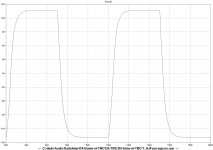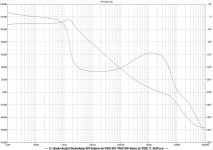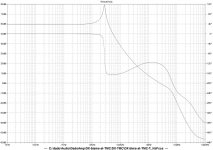This is simple amplifier with bootstraped CCS for the VAS. It uses deplation mode DMOS FET from Supertex for CCS.
There is TMC bridged with resistor//capacitor. OLG is 60dB up to 30kHz.
I started it from DX-blame+TMC showed in other tread. If anybody is interested I'll give more information next. The schematic and OLG diagrasm are here.
I am not good at explaining the sound but this one is really good and I built a few , some with ordinary Miller comp. and JLH 80W I modified and showed.
dado
There is TMC bridged with resistor//capacitor. OLG is 60dB up to 30kHz.
I started it from DX-blame+TMC showed in other tread. If anybody is interested I'll give more information next. The schematic and OLG diagrasm are here.
I am not good at explaining the sound but this one is really good and I built a few , some with ordinary Miller comp. and JLH 80W I modified and showed.
dado
Attachments
Simulated distortion:
Fourier components of V(vout)
DC component:-0.123002
Harmonic Frequency Fourier Normalized Phase Normalized
Number [Hz] Component Component [degree] Phase [deg]
1 1.000e+03 1.377e+01 1.000e+00 -0.06° 0.00°
2 2.000e+03 6.783e-06 4.927e-07 95.95° 96.01°
3 3.000e+03 5.201e-06 3.778e-07 6.34° 6.40°
4 4.000e+03 9.890e-07 7.183e-08 91.85° 91.90°
5 5.000e+03 2.363e-06 1.717e-07 9.34° 9.39°
6 6.000e+03 4.449e-07 3.232e-08 82.57° 82.63°
7 7.000e+03 2.181e-06 1.584e-07 13.33° 13.39°
8 8.000e+03 2.356e-07 1.711e-08 51.69° 51.74°
9 9.000e+03 1.716e-06 1.247e-07 16.95° 17.01°
Total Harmonic Distortion: 0.000068%
Fourier components of V(vout)
DC component:-0.123009
Harmonic Frequency Fourier Normalized Phase Normalized
Number [Hz] Component Component [degree] Phase [deg]
1 1.000e+04 1.377e+01 1.000e+00 -0.56° 0.00°
2 2.000e+04 9.090e-06 6.603e-07 -171.24° -170.68°
3 3.000e+04 4.880e-06 3.545e-07 86.39° 86.94°
4 4.000e+04 1.457e-06 1.058e-07 -145.16° -144.60°
5 5.000e+04 6.730e-06 4.889e-07 141.24° 141.80°
6 6.000e+04 1.568e-06 1.139e-07 -111.62° -111.06°
7 7.000e+04 1.283e-05 9.323e-07 155.56° 156.12°
8 8.000e+04 1.314e-06 9.542e-08 -93.61° -93.05°
9 9.000e+04 1.662e-05 1.207e-06 162.10° 162.66°
Total Harmonic Distortion: 0.000178%
Fourier components of V(vout)
DC component:-0.123031
Harmonic Frequency Fourier Normalized Phase Normalized
Number [Hz] Component Component [degree] Phase [deg]
1 2.000e+04 1.376e+01 1.000e+00 -1.11° 0.00°
2 4.000e+04 3.361e-05 2.442e-06 -132.92° -131.81°
3 6.000e+04 1.605e-05 1.166e-06 168.43° 169.54°
4 8.000e+04 6.275e-06 4.559e-07 -100.98° -99.87°
5 1.000e+05 2.923e-05 2.123e-06 160.31° 161.42°
6 1.200e+05 6.898e-06 5.011e-07 -86.47° -85.36°
7 1.400e+05 5.209e-05 3.785e-06 167.36° 168.47°
8 1.600e+05 5.646e-06 4.102e-07 -75.58° -74.47°
9 1.800e+05 6.403e-05 4.652e-06 171.51° 172.62°
Total Harmonic Distortion: 0.000696%
FFT:
Fourier components of V(vout)
DC component:-0.123002
Harmonic Frequency Fourier Normalized Phase Normalized
Number [Hz] Component Component [degree] Phase [deg]
1 1.000e+03 1.377e+01 1.000e+00 -0.06° 0.00°
2 2.000e+03 6.783e-06 4.927e-07 95.95° 96.01°
3 3.000e+03 5.201e-06 3.778e-07 6.34° 6.40°
4 4.000e+03 9.890e-07 7.183e-08 91.85° 91.90°
5 5.000e+03 2.363e-06 1.717e-07 9.34° 9.39°
6 6.000e+03 4.449e-07 3.232e-08 82.57° 82.63°
7 7.000e+03 2.181e-06 1.584e-07 13.33° 13.39°
8 8.000e+03 2.356e-07 1.711e-08 51.69° 51.74°
9 9.000e+03 1.716e-06 1.247e-07 16.95° 17.01°
Total Harmonic Distortion: 0.000068%
Fourier components of V(vout)
DC component:-0.123009
Harmonic Frequency Fourier Normalized Phase Normalized
Number [Hz] Component Component [degree] Phase [deg]
1 1.000e+04 1.377e+01 1.000e+00 -0.56° 0.00°
2 2.000e+04 9.090e-06 6.603e-07 -171.24° -170.68°
3 3.000e+04 4.880e-06 3.545e-07 86.39° 86.94°
4 4.000e+04 1.457e-06 1.058e-07 -145.16° -144.60°
5 5.000e+04 6.730e-06 4.889e-07 141.24° 141.80°
6 6.000e+04 1.568e-06 1.139e-07 -111.62° -111.06°
7 7.000e+04 1.283e-05 9.323e-07 155.56° 156.12°
8 8.000e+04 1.314e-06 9.542e-08 -93.61° -93.05°
9 9.000e+04 1.662e-05 1.207e-06 162.10° 162.66°
Total Harmonic Distortion: 0.000178%
Fourier components of V(vout)
DC component:-0.123031
Harmonic Frequency Fourier Normalized Phase Normalized
Number [Hz] Component Component [degree] Phase [deg]
1 2.000e+04 1.376e+01 1.000e+00 -1.11° 0.00°
2 4.000e+04 3.361e-05 2.442e-06 -132.92° -131.81°
3 6.000e+04 1.605e-05 1.166e-06 168.43° 169.54°
4 8.000e+04 6.275e-06 4.559e-07 -100.98° -99.87°
5 1.000e+05 2.923e-05 2.123e-06 160.31° 161.42°
6 1.200e+05 6.898e-06 5.011e-07 -86.47° -85.36°
7 1.400e+05 5.209e-05 3.785e-06 167.36° 168.47°
8 1.600e+05 5.646e-06 4.102e-07 -75.58° -74.47°
9 1.800e+05 6.403e-05 4.652e-06 171.51° 172.62°
Total Harmonic Distortion: 0.000696%
FFT:
Attachments
That's pretty good, Dadod!
Very clean, absolutely no sound of its own?
Any sibilance? How is the image depth?
As you realise of course, these qualities cannot be measured.
Hugh
Hi Hugh,
Thank you for your interest.
I can say first what equipment I am using.
Source: Denon DVD-3910
Turntable BIX(belt drive) with MC Denon DL103, Cambidge Audio 640P MC
preamp with LM4562 OPAMPs
Tuner NAD 402
Pream: Aikido tube pre(now in reconstruction to get better look)
Solidstate hand made with LME49860
Amp: This one
JLH 80W MOSFET modified by me
Lodspeaker: Hand made with ScanSpeak woofer(18W/8545-00) in closed box and
midhigh ribbon Newfor Reaserch R30
So this is good enough for good listening.
I do not hear any sibilance and the image depth is good, as I go on live classical concert I have that live concert filling wile listning my setup.
I've got function generator and oscilograph but no distortion measuring equipmen.
I have to bay a good external PC sound card and use some of good software for it.
Some more photografs and diagrams.
Square wave no different up to 1.5uF parallel to 8 ohm.
dado
Attachments
Very good , DADOD. I gave up in my mix of the bootstrap and TMC , you did not and even added the CCS to the mix !
A few questions .... how do you know you are not listening to your sources (tube preamps , etc) while subjectively accessing the main amp ??
Have you built just a "CCS only" TMC amp to compare to ?
A comment .... I use just a portable music player with either 320kbs mp3's or lossless codec music run DIRECTLY to the amp. No "middlemen" to cloud up the judgement.
As far as the bootstrap having "better bass" , this is because of the cap's effect on the VAS impedance/ damping factor of the OPS. A triple OPS , with it's ultra high current gain/ rock solid damping , will give this effect as will a fully balanced VAS (commonly used by OEM's for subwoofer only amps). My 4 transistor MJE340/350 VAS will be my next "bass only" amp , since it absolutely sounds the best with a dedicated bass driver.
It is the complex interaction between loudspeaker/OPS/VAS that determines the "better bass".
It is good to see someone else both simulating AND building/listening , the proper combination of both techniques is the only way to attain anything outstanding.
OS
OS
A few questions .... how do you know you are not listening to your sources (tube preamps , etc) while subjectively accessing the main amp ??
Have you built just a "CCS only" TMC amp to compare to ?
A comment .... I use just a portable music player with either 320kbs mp3's or lossless codec music run DIRECTLY to the amp. No "middlemen" to cloud up the judgement.
As far as the bootstrap having "better bass" , this is because of the cap's effect on the VAS impedance/ damping factor of the OPS. A triple OPS , with it's ultra high current gain/ rock solid damping , will give this effect as will a fully balanced VAS (commonly used by OEM's for subwoofer only amps). My 4 transistor MJE340/350 VAS will be my next "bass only" amp , since it absolutely sounds the best with a dedicated bass driver.
It is the complex interaction between loudspeaker/OPS/VAS that determines the "better bass".
It is good to see someone else both simulating AND building/listening , the proper combination of both techniques is the only way to attain anything outstanding.
OS
OS
Very good , DADOD. I gave up in my mix of the bootstrap and TMC , you did not and even added the CCS to the mix !
A few questions .... how do you know you are not listening to your sources (tube preamps , etc) while subjectively accessing the main amp ??
Have you built just a "CCS only" TMC amp to compare to ?
A comment .... I use just a portable music player with either 320kbs mp3's or lossless codec music run DIRECTLY to the amp. No "middlemen" to cloud up the judgement.
As far as the bootstrap having "better bass" , this is because of the cap's effect on the VAS impedance/ damping factor of the OPS. A triple OPS , with it's ultra high current gain/ rock solid damping , will give this effect as will a fully balanced VAS (commonly used by OEM's for subwoofer only amps). My 4 transistor MJE340/350 VAS will be my next "bass only" amp , since it absolutely sounds the best with a dedicated bass driver.
It is the complex interaction between loudspeaker/OPS/VAS that determines the "better bass".
It is good to see someone else both simulating AND building/listening , the proper combination of both techniques is the only way to attain anything outstanding.
OS
OS
OS,
You are asking very hard to answer questions.
My source and loudspeaker are always the same, and for sure they influece the sound.
I was listening to ordinary bootstrap+TMC and now I am listening this new amp.
What is better, I think this new one. You have sead in your tread that ordinary boostrap is not improved by adding TMC, and I added CCS to the bootstrap.
One think more, this amp is incorporated in an old case with old power supply and quite old capacitors inside. So it could be improved with better power suppla, but is still sounds very good, no listening fatigue.
I am in process to finish ThermalTrak amp with triple OPS and will show it on this forum.
I will suggest similar one with ordinary output BJTs too.
I enjoy in this hobby and SPICE tool could be so addicted and but impossible to bild everything.
Actually I am bilding two amps with three channels in each one for my ORION speakers.
dado
would it be possible to remove the output transistors and instead drive a set of lateral fets where the drivers are located...thus take a full stage out of the amplifier....(I like lateral outputs)
I think it is possible. JLH 80W MOSFET amp does not use drivers and VAS current is similar cca 10mA. I like the sound of JLH amp with laterals. If to use drivers even better.
Question for Hugh and OS!
You probably notice tha I use local feedback on VAS, that bridge over TMC(1meg//5pF).
It decreases open loop gain at low frequences from more then 100dB to litle less then 60dB and kip it up to 30kHz.
Some says that there is no benefit in it, but I coud not resist but to tray it.
What is you oppinion??
dado
You probably notice tha I use local feedback on VAS, that bridge over TMC(1meg//5pF).
It decreases open loop gain at low frequences from more then 100dB to litle less then 60dB and kip it up to 30kHz.
Some says that there is no benefit in it, but I coud not resist but to tray it.
What is you oppinion??
dado
I saw it , (1meg/5pF) . It's NOT lead compensation. It would have a minor effect on both the TMC transition and the unity gain point. Being INSIDE the miller loop it would be most likely overwhelmed by the main Cdom. ??? 
PS. It might not have much more effect than a couple very long traces on a PCB.
OS
PS. It might not have much more effect than a couple very long traces on a PCB.
OS
Last edited:
I can't see the rational for cutting loop gain at audio frequencies - the very complete follow up analysis of Otala's ideas show his prescription of flat audio frequency loop gain is not in fact "the cure" for TIM/SID/FM IMD
the analysis and hardware measurements showed that high/"sloping" loop feedback can be used freely with other circuit modifications that do minimize these "time/phase" distortions
Walt Jung and Marshall Leach both published amp designs incorporating the flat audio frequency loop gain characteristic - and then later published that they had changed positions and determined that high feedback did not worsen Otala's proposed distortions
the sole "reason" to try flat audio frequency loop gain is the anecdotal comments by people who freely state that DBT is too "insensitive" to reveal differences in listening tests of amps designed according to their "principles"
I don't know of any reason to worry over loop gain peaking - although it is "inefficient" in the Bode Integral feedback limit analysis for a broad working band
but it is certainly minimized by allowing the gain to be large with multiple slopes in the audio frequency range
I would consider guarding/shielding the mirror out/VAS buffer end node just to maximize loop gain
the analysis and hardware measurements showed that high/"sloping" loop feedback can be used freely with other circuit modifications that do minimize these "time/phase" distortions
Walt Jung and Marshall Leach both published amp designs incorporating the flat audio frequency loop gain characteristic - and then later published that they had changed positions and determined that high feedback did not worsen Otala's proposed distortions
the sole "reason" to try flat audio frequency loop gain is the anecdotal comments by people who freely state that DBT is too "insensitive" to reveal differences in listening tests of amps designed according to their "principles"
I don't know of any reason to worry over loop gain peaking - although it is "inefficient" in the Bode Integral feedback limit analysis for a broad working band
but it is certainly minimized by allowing the gain to be large with multiple slopes in the audio frequency range
I would consider guarding/shielding the mirror out/VAS buffer end node just to maximize loop gain
Last edited:
Dadod,
Very high loop gains require more lag compensation to pull back to unity loop gain by the upper pole frequency. This gives a very clean sound, but can sound somewhat artificial. I find there are benefits in reducing loop gain with VAS local feedback too, but you can also use nested feedback to achieve the same thing. This will have the benefit of lowering VAS output impedance, which in turn reduces voltage distortion to the output stage. I designed an amplifier with only 16dB of global feedback using a double EF output stage and the sound was punchy, alive and powerful, quite the opposite of what you would expect.
I agree emphatically with OS about the complex interaction with the VAS, OPS and speaker giving good bass. It is not solely a function of damping factor. A speaker is a complex active load, and the back emf fed directly into the feedback loop causes a reducton in the image depth.
A good means of decoupling the VAS from the OPS is to use a small mosfet as the VAS, since these are fast devices, and completely isolate the gate from the drain and source.
If you are thoroughly adjusted to your source and speakers, then new amps will be easy to pick. While I agree with OS about a simple source, I do feel that you can easily 'hear' a new amp if the rest of your system remains unchanged and you are well used to it.
As JCX said, you should strive to keep loop gain consistent across the audio band so that distortion at the high frequencies is held to similar levels as at low frequencies. This is quite difficult but I get the feeling TMC helps.
Current swings in the VAS are not too troublesome, because they promote asymmetrical distortion, which is almost completely even order. It is odd order you have to be careful about. Moreover, bass sounds better with a little H2 mixed in; it wettens it, adding a bit of decay, which is musically more satisfying. Many people prefer tube bass for this reason; decay is important and militates against a super high damping factor.
Thank you for sharing your design,
Hugh
Very high loop gains require more lag compensation to pull back to unity loop gain by the upper pole frequency. This gives a very clean sound, but can sound somewhat artificial. I find there are benefits in reducing loop gain with VAS local feedback too, but you can also use nested feedback to achieve the same thing. This will have the benefit of lowering VAS output impedance, which in turn reduces voltage distortion to the output stage. I designed an amplifier with only 16dB of global feedback using a double EF output stage and the sound was punchy, alive and powerful, quite the opposite of what you would expect.
I agree emphatically with OS about the complex interaction with the VAS, OPS and speaker giving good bass. It is not solely a function of damping factor. A speaker is a complex active load, and the back emf fed directly into the feedback loop causes a reducton in the image depth.
A good means of decoupling the VAS from the OPS is to use a small mosfet as the VAS, since these are fast devices, and completely isolate the gate from the drain and source.
If you are thoroughly adjusted to your source and speakers, then new amps will be easy to pick. While I agree with OS about a simple source, I do feel that you can easily 'hear' a new amp if the rest of your system remains unchanged and you are well used to it.
As JCX said, you should strive to keep loop gain consistent across the audio band so that distortion at the high frequencies is held to similar levels as at low frequencies. This is quite difficult but I get the feeling TMC helps.
Current swings in the VAS are not too troublesome, because they promote asymmetrical distortion, which is almost completely even order. It is odd order you have to be careful about. Moreover, bass sounds better with a little H2 mixed in; it wettens it, adding a bit of decay, which is musically more satisfying. Many people prefer tube bass for this reason; decay is important and militates against a super high damping factor.
Thank you for sharing your design,
Hugh
flat loop gain == rising distortion with frequency
I must have been too indirect - that is nearly the opposite conclusion from how I interpret the research, theory, practice
there are several distortion mechanisms that rise with frequency - in fact they cause rising phase shift nonlinearity with frequency too - independent of loop gain slope - so for flat loop gain amps the distortion does rise with frequency
with higher loop gain the distortion rises to the same level that it gets to with the same amp "flat loop gain compensated" - but the distortion at all frequencies below the corner is lower
I would point to Self, Cordell and even our low/"no" feedback designers like Pass and Curl here to suggest that the output stage looks pretty feeble - even at 100 W parallel output devices are a good idea for multidriver dynamic loudspeaker with possible 2 Ohm impedance dips due to bad XO design
and triple EF seems like a requirement to avoid load impedance and Q beta nonlinearity from limiting VAS performance
when those measures are in place I think the "back emf"/complex load arguments are way less relevant
Dadod,
...As JCX said, you should strive to keep loop gain consistent across the audio band so that distortion at the high frequencies is held to similar levels as at low frequencies. This is quite difficult but I get the feeling TMC helps.
...Hugh
I must have been too indirect - that is nearly the opposite conclusion from how I interpret the research, theory, practice
there are several distortion mechanisms that rise with frequency - in fact they cause rising phase shift nonlinearity with frequency too - independent of loop gain slope - so for flat loop gain amps the distortion does rise with frequency
with higher loop gain the distortion rises to the same level that it gets to with the same amp "flat loop gain compensated" - but the distortion at all frequencies below the corner is lower
I would point to Self, Cordell and even our low/"no" feedback designers like Pass and Curl here to suggest that the output stage looks pretty feeble - even at 100 W parallel output devices are a good idea for multidriver dynamic loudspeaker with possible 2 Ohm impedance dips due to bad XO design
and triple EF seems like a requirement to avoid load impedance and Q beta nonlinearity from limiting VAS performance
when those measures are in place I think the "back emf"/complex load arguments are way less relevant
Moreover, bass sounds better with a little H2 mixed in; it wettens it, adding a bit of decay, which is musically more satisfying. Many people prefer tube bass for this reason; decay is important and militates against a super high damping factor.
Thank you for sharing your design,
Hugh
There are two points here:
1) "High damping factor" is a bit a misnomer IMO, low output impedance is a better description. The problem with low output impedance is potentially an under-damped response to reactive loads and back EMF. Poor reactive load transient response combined with poor transient response from ported speakers systems means poor bass and timing. A bit of damping achieved by adding some output resistance can help here.
2) "a little H2 mixed in":- I cannot agree with this. If this does indeed add "decay" as you suggest, then surely it's going to mess up the timing (which incidentaly is the reason I sold my AKSAs). I would advocate getting some speakers with accurate bass.
Or maybe people don't actually want bass that starts and stops properly?
"High damping factor" is a bit a misnomer IMO, low output impedance is a better description.
David, this is semantics, superficial nonsense. You know as well as I do that damping factor is the ratio of load to source impedance.
"a little H2 mixed in":- I cannot agree with this.
Again, you know well that SETs inject a great deal of H2 and that this is indeed enjoyed by many audiophiles. Adding some output resistance simply hikes up output impedance, lowering damping factor and achieving precisely what I was alluding to.
(which incidentaly is the reason I sold my AKSAs).
You mustn't kick yourself for your apparent 'poor judgement' buying the AKSA, which you obtained by crafty negotation anyway. I would hope you sold it for a good price! This is a cheap shot, and completely unsolicited.
I would advocate getting some speakers with accurate bass.
More gratuitous criticism, really, why don't you use the forum for its intended purpose, to swap information of genuine use to other people?
Hugh
I would point to Self, Cordell and even our low/"no" feedback designers like Pass and Curl here to suggest that the output stage looks pretty feeble - even at 100 W parallel output devices are a good idea for multidriver dynamic loudspeaker with possible 2 Ohm impedance dips due to bad XO design
and triple EF seems like a requirement to avoid load impedance and Q beta nonlinearity from limiting VAS performance
Agree for the necessity of a beefed OS , but triple EF
is quite annoying on the stability front...
As a cure , lateral fets OPS bring lots of benefits and very few
drawbacks if any...
- Home
- Amplifiers
- Solid State
- bootstrapsCCS+T-TMC
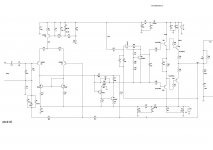
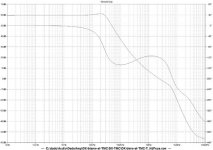
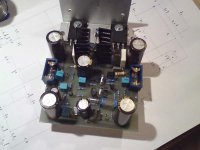
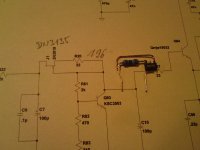
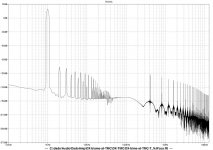
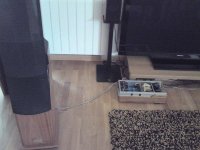
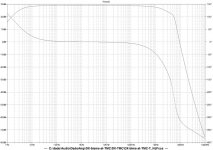
![DADO-T-TMC -bCCS-mirror.LAY].jpg](/community/data/attachments/211/211500-02bc6f333c7a1ad5810afe58d7e4434f.jpg)
